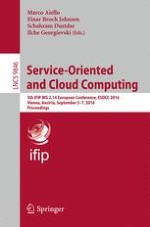2016 | Buch
Service-Oriented and Cloud Computing
5th IFIP WG 2.14 European Conference, ESOCC 2016, Vienna, Austria, September 5-7, 2016, Proceedings
herausgegeben von: Marco Aiello, Einar Broch Johnsen, Schahram Dustdar, Ilche Georgievski
Verlag: Springer International Publishing
Buchreihe : Lecture Notes in Computer Science
